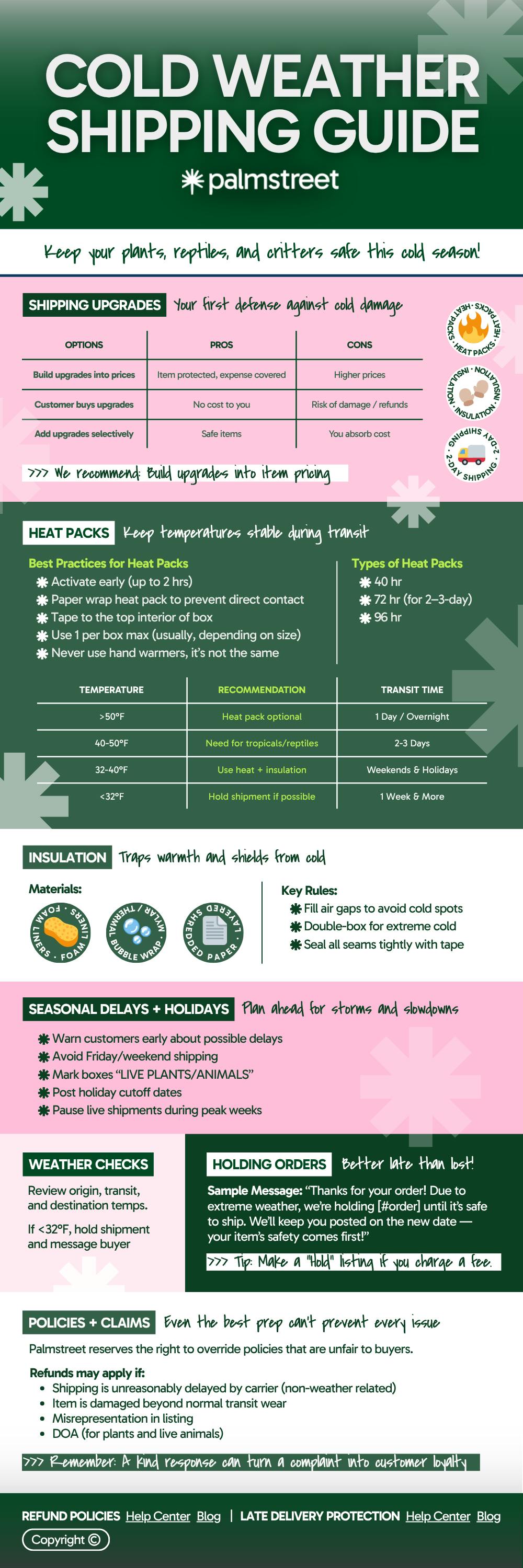

Palmstreet Official
In many parts of the country, the temps begin to drop once October hits. This greatly impacts the shipping of delicate living items like plants, reptiles, and other critters. The show must go on and business doesn’t stop just because of these challenges, which is why we made this list of cold weather shipping tips! Use this guide to package your Palmstreet items this winter season:
Shipping upgrades are your best friend when it comes to shipping plants in the winter months. There are three main types of upgrades we recommend utilizing when shipping in cold temps: heat packs, insulation, and 2-day shipping. You can make it easy for your customers and offer all 3 as a winter bundle for one discounted price.
We’re going to outline three methods of using upgrades with the pros and cons of each:
1) You include the upgrades at no cost but you build the extra expense into your prices.
2) Customers are responsible for purchasing upgrades at their own discretion.
3) You include the upgrades when you think its necessary and eat the cost.
We highly recommend choosing the first option! It’s one of the best ways to ensure your packages arrive safely and undamaged. You’ll avoid disputes, disappointed customers, and unnecessary refunds. Customers may notice the increase in prices, but most of them will understand.
Heat packs are essential for shipping plants and critters in cold weather. These convenient packs are designed to activate and release steady heat to create a temperate environment during the shipping process. Heat packs are available for durations of 40, 72, or 96 hours. 72-hour heat packs are one of the most commonly used types because they work well with 2-day and 3-day shipping.
Always refer to the manufacturer’s instructions when using heat packs, but here are some common best practices:
When deciding whether to include a heat pack, look at origin, transit, and destination temperatures to be sure the shipment wont encounter temps below 50°F at any time during shipment. If you still aren’t sure if a heat pack is needed, use this as a guide:
Insulation keeps the interior of a package more stable against extreme cold. Using a heat pack without insulation will result in the warmth escaping too quickly, or the cold will penetrate too fast. For live plants and reptiles, insulation can mean the difference between safe delivery and loss.
Choose the Right Materials
Fill the Empty Space
Seal the Box Properly
The winter season brings extra challenges for shipping carriers. Storms and extreme weather have the potential to cause delays, in addition the increase in volume from holiday shipping in November and December. You can get ahead of the challenges by following a few best practices:
Always check the weather before shipping. If the customer’s location is experiencing a cold snap, snowstorm, or freezing temperatures, consider postponing the shipment. Communicate with customers using our Palmstreet direct messages if you decide to delay for safety reasons.
When in doubt, you can always hold the order. If temps are below freezing during any part of the shipping journey, it’s safer to hold the order than send it on its way. If this is the case, we recommend reaching out to the buyer as soon as possible to inform them of the delay. Here is a message example you can use to communicate with buyers in this scenario:
"Thanks so much for placing an order with us! Due to extreme weather, we are holding order [insert order number here] until it’s safe to ship. We value your business, and we want your item to be healthy when it arrives. If you have any questions, please let us know. We’ll keep you posted on a new shipping date for your order. "
**Many sellers choose to charge a fee when putting items on hold. An easy way to accomplish this is to create a listing for holds.
Even with careful preparation, it’s still likely you will encounter customer disputes related to winter shipping. Unhappy customers are an inevitable issue in any business, but it’s how you react that determines the outcome. Keep in mind that an unsatisfied customer can be turned into a loyal customer when you maintain a helpful attitude.
While we encourage sellers to create and uphold their own refund policies, Palmstreet reserves the right to override seller policies that are deemed unreasonable or unfair to buyers. Policies cannot completely exclude refunds for items that have:
Stay up to date on our refund policies here:
https://palmstreet.app/blog/palmstreet-refund-policy
Buyer can also take advantage of our late delivery protection:
https://palmstreet.app/blog/palmstreet-package-protection-policies
Need a quick recap? Save or share this Cold Weather Shipping Guide for easy reference this season:
